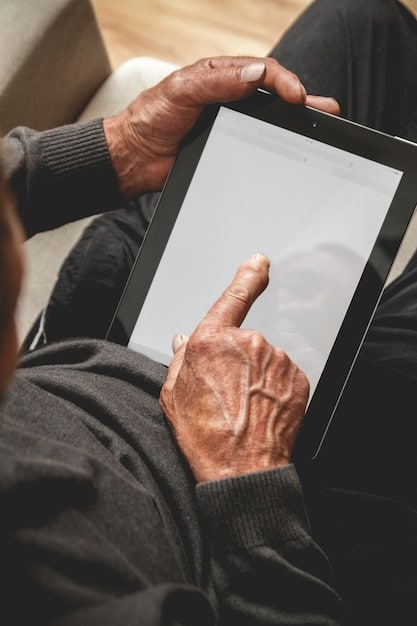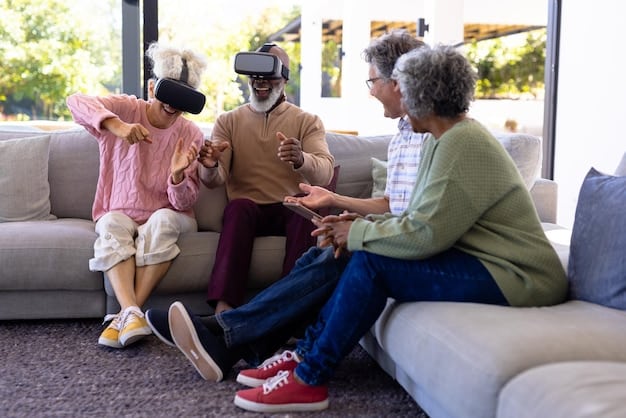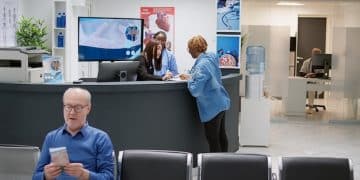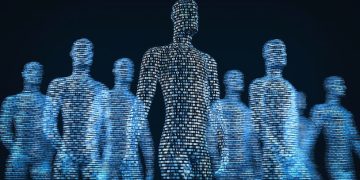Geriatric Care Tech: Solutions for US Aging Population

The growing demand for geriatric care technology necessitates innovative solutions to address the unique needs of the United States’ aging population, promising enhanced quality of life and more efficient healthcare delivery.
The landscape of healthcare is undergoing a profound transformation, driven largely by demographic shifts. In the United States, in particular, the significant increase in the elderly population presents both challenges and unparalleled opportunities for innovation. Understanding the growing demand for geriatric care technology: solutions for an aging US population is crucial for shaping a future where quality of life for seniors is not just maintained, but significantly enhanced through technological advancements.
The Demographic Imperative: An Aging Nation’s Needs
The United States is undeniably aging. Projections indicate that by 2030, one in five Americans will be over the age of 65, dramatically altering the societal fabric, economic structures, and, most notably, the healthcare system. This demographic shift isn’t merely a statistic; it represents a fundamental change in the needs and priorities of a significant portion of the population.
As individuals age, their healthcare requirements typically become more complex, encompassing a spectrum from chronic disease management to mobility assistance and cognitive support. The traditional healthcare model, often reactive and episodic, struggles to comprehensively address these long-term, intertwined needs. This growing gap highlights the urgent need for a proactive, integrated approach, one that technology is uniquely positioned to provide.
Understanding the unique challenges faced by seniors
Seniors face specific challenges that technology can help alleviate. These often include managing multiple chronic conditions, maintaining independence at home, and combating social isolation. Overcoming these hurdles is paramount for a high quality of life.
- Chronic Disease Management: Many older adults live with multiple chronic conditions like diabetes, heart disease, and arthritis, requiring constant monitoring.
- Mobility and Falls: Age-related mobility issues increase the risk of falls, a leading cause of injury and hospitalization among seniors.
- Cognitive Decline: Conditions like Alzheimer’s and dementia necessitate specialized care, memory aids, and safety monitoring.
- Social Isolation: Reduced social interaction can lead to depression and other mental health issues, impacting overall well-being.
Moreover, the caregiver burden is substantial. Family caregivers often juggle employment, their own families, and the demanding responsibilities of caring for an elderly loved one. Technology offers avenues to alleviate this burden, providing tools for remote monitoring, medication reminders, and even emotional support, thereby extending the capabilities of caregivers and promoting sustainable care models. The integration of technology in geriatric care is no longer a luxury but a necessity, paving the way for more efficient, person-centered support.
Addressing the demographic imperative with technological solutions is not just about extending lives but enriching them. It means creating ecosystems where seniors can age with dignity, maintain independence, and receive timely, personalized care, ultimately transforming the challenges of an aging population into opportunities for innovation and societal betterment.
Technological Innovations Revolutionizing Geriatric Care
The rapid pace of technological innovation is fundamentally reshaping how geriatric care is delivered, moving beyond traditional models to embrace solutions that enhance independence, improve health outcomes, and provide critical support for both seniors and their caregivers. These advancements are not merely incremental; they represent a paradigm shift in addressing the complex needs of an aging population.
One of the most impactful areas is remote patient monitoring (RPM). Devices ranging from wearable sensors that track vital signs to smart home systems that detect falls can collect real-time data, allowing healthcare providers to intervene proactively. This not only prevents hospital readmissions but also provides peace of mind for families, knowing their loved ones are safely monitored.
The rise of AI and machine learning in senior health
Artificial intelligence (AI) and machine learning (ML) are becoming central to personalized geriatric care. These technologies can analyze vast amounts of health data to predict potential health crises, identify individualized care pathways, and even assist with early diagnosis of conditions like dementia.
- Predictive Analytics: AI algorithms can analyze historical health data to predict future health events, such as the likelihood of a fall or the onset of a chronic condition exacerbation.
- Personalized Treatment Plans: Machine learning can tailor medication regimens, dietary advice, and exercise plans based on an individual’s unique health profile and responses to treatment.
- Diagnostic Support: AI can assist clinicians in diagnosing complex conditions earlier by identifying subtle patterns in medical images or patient data that human eyes might miss.
- Medication Adherence: AI-powered apps or smart devices can send personalized reminders, track medication intake, and alert caregivers to missed doses.
Beyond diagnostics and monitoring, AI-powered conversational agents and social robots are emerging as companions for seniors, combating social isolation and providing cognitive stimulation. These tools can engage in conversation, remind about appointments, and even facilitate virtual family visits, offering a new dimension of emotional and social support. The integration of these innovative technologies enables a more proactive, personalized, and preventative approach to geriatric care, moving healthcare into the everyday lives of seniors and fostering a greater sense of autonomy and well-being.

Smart Home Technology and Senior Safety
For many seniors, staying in their own homes for as long as possible is a deeply cherished goal. Smart home technology plays a pivotal role in making this a safe and viable option, addressing concerns about falls, emergency response, and overall well-being. These integrated systems transform ordinary residences into supportive environments tailored to the needs of older adults.
Motion sensors and smart lighting can automatically illuminate pathways at night, significantly reducing the risk of falls. Voice-activated devices allow seniors to control lights, thermostats, and entertainment systems without needing to physically move, providing convenience and boosting independence. Automated door locks and smart security cameras enhance safety and allow family members or caregivers to monitor access remotely.
Emergency response systems and fall detection
Perhaps most critically, smart home technology is revolutionizing emergency response for seniors. Personal Emergency Response Systems (PERS) have evolved significantly, now often integrating with smart home platforms to offer more comprehensive safety nets.
- Wearable Devices: Smartwatches and pendants with built-in fall detection can automatically alert caregivers or emergency services immediately if a fall occurs.
- Environmental Sensors: Non-wearable sensors placed throughout the home can detect unusual movement patterns or absence of movement, signaling a potential issue.
- Integrated Communication: Systems can connect directly to emergency services or pre-programmed contacts, allowing for swift response without the senior needing to manually dial.
- Voice-Activated Assistants: In an emergency, seniors can simply use voice commands to call for help, even if they are unable to reach a phone.
These advanced systems provide invaluable peace of mind, knowing that help is automatically dispatched during critical moments. Beyond emergencies, smart home technology can monitor daily routines, alerting caregivers to significant deviations that might indicate a health issue. For example, if a senior hasn’t used the kitchen or bathroom for an unusually long period, the system can send an alert. This discreet monitoring allows seniors to maintain their privacy and autonomy while ensuring a supportive safety net is always in place, effectively extending independent living years and providing critical reassurance to their families.
Telehealth and Remote Care: Bridging Distances
Telehealth, once a niche concept, has rapidly become an indispensable component of modern healthcare, particularly for geriatric populations. It effortlessly bridges geographical distances, bringing specialized medical expertise directly into seniors’ homes, regardless of their location. This shift minimizes the need for arduous travel to appointments, reducing physical strain and logistical challenges for both patients and their caregivers.
Virtual consultations allow seniors to connect with their physicians, specialists, and even mental health professionals via video calls. This convenience is transformative for those with mobility limitations or living in rural areas with limited access to care. It ensures continuity of care, facilitates medication reviews, and provides timely medical advice, all from the comfort and safety of home.
Expanding access to specialized geriatric services
The true power of telehealth lies in its ability to expand access to specialized geriatric services that might otherwise be unavailable. Many regions lack sufficient numbers of geriatricians, neurologists, or other specialists critical for complex senior health needs. Telehealth effectively broadens the reach of these experts.
- Specialist Consultations: Seniors can consult with geriatricians, endocrinologists, cardiologists, and other specialists located anywhere, overcoming local demographic shortages.
- Mental Health Support: Access to therapists and psychiatrists through virtual platforms can address the often-overlooked mental health challenges faced by older adults, reducing stigma and improving outcomes.
- Rehabilitation and Physical Therapy: Remote physical therapy sessions, guided by a therapist via video, allow seniors to continue rehabilitation exercises consistently at home.
- Caregiver Support: Telehealth platforms can also offer virtual support groups and educational sessions for caregivers, providing much-needed resources and community.
Beyond individual appointments, remote monitoring devices seamlessly integrate with telehealth platforms, allowing physicians to continuously track vital signs, glucose levels, or cardiac rhythms. This real-time data enables proactive adjustments to care plans and early intervention, preventing potential crises. The seamless integration of telehealth significantly reduces hospitalizations and emergency room visits, contributing to a more efficient and patient-centered healthcare system. Ultimately, telehealth fosters a more connected and responsive care ecosystem, ensuring seniors receive high-quality, continuous care, enhancing their well-being and independence while alleviating pressures on traditional healthcare facilities.

Wearable Devices and Personalized Health Monitoring
Wearable technology has moved far beyond simple fitness trackers, evolving into sophisticated health monitoring tools that offer unprecedented insights into individual well-being. For the geriatric population, these devices provide a continuous, passive flow of health data, empowering both seniors and their healthcare providers with actionable information that supports personalized care and proactive health management.
From smartwatches that monitor heart rate and detect irregular rhythms to patches that track sleep patterns and body temperature, wearables collect data that can signal subtle changes in health. This passive monitoring is particularly valuable for conditions that might not have obvious symptoms or for individuals who might not regularly self-report their health status. The discreet nature of these devices makes them ideal for daily use, integrating seamlessly into a senior’s routine.
Empowering seniors with data and autonomy
The true advantage of wearable technology is not just in data collection, but in the empowerment it offers to seniors themselves. Access to their own health data can foster greater self-awareness and encourage active participation in managing their health.
- Activity Tracking: Monitoring steps, active minutes, and calorie burn can motivate seniors to maintain a consistent exercise routine, improving cardiovascular health and mobility.
- Sleep Analysis: Detailed sleep patterns can reveal potential sleep disorders or lifestyle factors affecting rest, allowing for targeted interventions.
- Fall Detection and Alerts: Many wearables now include advanced fall detection features that automatically alert emergency contacts or services after a sudden impact.
- Vital Sign Monitoring: Continuous tracking of metrics like heart rate, blood pressure (in some models), and oxygen saturation provides early warnings for potential health issues.
Moreover, these devices can be programmed to send medication reminders, track adherence, and even facilitate virtual connections with family and care teams. For example, a senior’s smartwatch could remind them to take their evening medication and then confirm adherence to a family member or nurse. This level of personalized, continuous monitoring enables healthcare providers to make more informed decisions, adjust treatment plans in real-time, and intervene proactively before minor issues escalate into major health crises. By empowering seniors with data and providing a reliable safety net, wearable devices are transforming how we approach preventative care and chronic disease management, promoting longer, healthier, and more independent lives.
Leveraging AI and Robotics for Enhanced Geriatric Support
The integration of artificial intelligence (AI) and robotics is rapidly advancing, promising to revolutionize geriatric support beyond traditional care models. These technologies offer innovative solutions to address labor shortages in healthcare, provide personalized assistance, and enhance the social and emotional well-being of older adults. Their potential lies in their ability to perform repetitive tasks, analyze complex data, and offer companionship in ways previously unimaginable.
AI-powered systems can analyze vast datasets of patient information to predict potential health declines, such as the risk of strokes or heart attacks, allowing for earlier preventative measures. Robotic assistants, from those that help with mobility to those that assist with daily tasks, can alleviate physical burdens on caregivers and empower seniors to maintain independence at home. These are not merely futuristic concepts but are becoming practical realities within various care settings.
The role of social robots in combating isolation
One of the most profound applications of AI and robotics in geriatric care is in addressing social isolation and loneliness, prevalent issues among older adults that significantly impact health and well-being. Social robots are designed to engage, interact, and provide companionship.
- Conversation and Engagement: Robots like PARO, a therapeutic seal robot, can respond to touch and voice, providing comfort and stimulating social interaction.
- Cognitive Stimulation: Some robots are equipped with games and memory exercises that help maintain cognitive function and delay the progression of cognitive decline.
- Routine Reminders: Robots can act as helpful assistants, reminding seniors about medication schedules, appointments, and even to stay hydrated.
- Facilitating Connection: Advanced social robots can facilitate video calls with family and friends, helping seniors stay connected to their loved ones.
Furthermore, AI-driven personal assistants, embedded in smart speakers or tablets, can provide round-the-clock support, answering questions, playing music, or connecting seniors to emergency services with simple voice commands. The development of assistive robots for tasks like retrieving objects or aiding in dressing further reduces dependence on human caregivers, promoting greater autonomy. While these technologies are not meant to replace human interaction, they serve as powerful complements, extending the reach of care, reducing the burden on human caregivers, and creating more supportive, engaging, and dignified environments for seniors. The ethical considerations surrounding privacy and data security are paramount in this development, ensuring that technology serves to enhance human connection and care, rather ironically, through advanced automation.
Addressing Challenges in Geriatric Technology Adoption
While the potential of geriatric care technology is immense, its widespread adoption faces several significant hurdles. These challenges span from economic accessibility to issues of digital literacy and ensuring the ethical implementation of advanced systems. Overcoming these barriers is crucial for technology to truly serve the aging population effectively and equitably.
One primary concern is the cost. Many advanced technological solutions, especially those integrating AI and robotics, come with a substantial price tag, making them inaccessible for a large segment of the elderly population living on fixed incomes. Insurance coverage for these technologies is still evolving, often lagging behind technological advancements, leaving many families to bear the financial burden themselves. This exacerbates existing health disparities, as only those with significant financial resources can fully benefit from these innovations.
Overcoming digital literacy gaps and trust issues
Another major challenge lies in digital literacy and trust. Many older adults may not be familiar with using modern technology, or they may feel intimidated by complex interfaces. This digital divide can prevent them from adopting tools that could significantly improve their quality of life.
- Simplistic User Interfaces: Designing technology with intuitive, easy-to-use interfaces that require minimal technical knowledge is key.
- Tailored Training Programs: Providing accessible, patient-focused training and ongoing support can help seniors become comfortable and confident with new devices.
- Addressing Privacy Concerns: Clearly communicating how personal health data is collected, stored, and used is essential to build trust, especially with AI-powered monitoring systems.
- Demonstrating Tangible Benefits: Showcasing the immediate and visible benefits of technology, like improved safety or easier communication, can increase willingness to adopt.
Furthermore, concerns around privacy, data security, and the potential for a perceived loss of human connection must be carefully addressed. Seniors and their families need reassurance that their data is protected and that technology will enhance, not replace, meaningful human interaction. Overcoming these challenges requires a multi-faceted approach involving policy changes to improve affordability and reimbursement, educational initiatives to boost digital literacy, and user-centric design that prioritizes simplicity and privacy. Ultimately, successful adoption hinges on making geriatric technology not just innovative, but also affordable, user-friendly, and trustworthy for the diverse needs of the aging US population.
| Key Point | Brief Description |
|---|---|
| 📊 Demographic Shift | Aging US population drives demand for innovative geriatric care solutions. |
| 💡 Tech Innovations | AI, robotics, and wearables are transforming senior health monitoring and autonomy. |
| 🏠 Smart Home & Telehealth | Enabling independent living and remote access to specialized medical care. |
| ⚙️ Adoption Challenges | Addressing cost, digital literacy, and trust is crucial for wider integration. |
Frequently asked questions about geriatric care technology
▼
Geriatric care technology encompasses a range of devices, software, and systems designed to improve the health, safety, and quality of life for older adults. This includes remote monitoring systems, smart home devices, telehealth platforms, wearable health trackers, and assistive robotics.
▼
Technology aids independence by providing safety features like fall detection, facilitating remote access to healthcare via telehealth, and offering smart home solutions that automate daily tasks. It also helps manage chronic conditions and provides companionship through social robots, reducing reliance on constant human intervention.
▼
Affordability remains a significant challenge. While some basic devices are becoming more accessible, advanced AI and robotic solutions can be expensive. Insurance coverage is still limited for many of these technologies, creating financial barriers for many seniors and their families.
▼
Key privacy concerns revolve around the collection and security of sensitive health and personal data by monitoring devices and AI systems. Ensuring robust data encryption, clear consent protocols, and transparency about data usage are crucial to building and maintaining trust among users.
▼
No, technology is not intended to replace human caregivers but rather to augment and support their efforts. It can handle routine tasks, provide continuous monitoring, and offer companionship, allowing human caregivers to focus on more complex care needs and interpersonal interactions. Human empathy and personalized touch remain irreplaceable.
Conclusion
The burgeoning demand for geriatric care technology in the United States reflects a critical societal need driven by a rapidly aging population. From sophisticated AI-driven analytics and robotics to practical smart home solutions and wearable devices, technology presents powerful avenues to enhance the quality of life, maintain independence, and ensure the safety of older adults. While significant challenges remain in terms of affordability, digital literacy, and ethical considerations, the ongoing innovation and dedicated efforts to overcome these hurdles promise a future where technology plays an increasingly central role in delivering compassionate, efficient, and personalized geriatric care. Embracing these advancements is not just a healthcare imperative; it is an investment in the dignity and well-being of our elders, reshaping the landscape of aging in America for generations to come.





